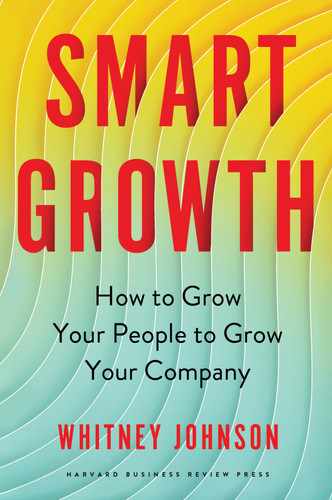S Curve Implications for Smart Growth Leaders
The S Curve of Learning gives leaders and their people a shared language for conversations around talent development; healthy longevity at any organization is driven by a worker’s perception of their opportunities to grow and develop.
A smart growth leader understands that we all want to make progress, but don’t always know how. Sometimes, we don’t know where to start or even believe we can start. Once we do start, we can struggle to gain and maintain momentum, and once we have made considerable progress, we may tire of what we’ve been doing and need to do something new. A smart growth leader gives people the power to make progress by helping them navigate the entire growth cycle—or S Curve of Learning—from the launch point to sweet spot to mastery.
The S Curve Insight Platform, briefly mentioned in the introduction, is a smart growth tool that tracks and monitors individual and collective progress. A fifteen-minute assessment, it indicates how individuals perceive their progress (a powerful undercurrent in every organization), what tools they are employing to maximize their growth, and whether they feel the ecosystem (culture) is helping or hindering their growth. Its results can inform talent development, retention, and workforce and succession planning.1
A smart growth leader builds teams with a portfolio of individual S Curves that matches a company’s current needs and objectives. Though percentages will vary depending on your industry, size of company, and stage of growth, use the bell-curve distribution as a starting point, with a small percentage of people on launch point and in mastery, and most of your people in the sweet spot at any given time. Track patterns among teams and across departments and business units. If, for example, most people on the sales team are on the launch point, how does this impact launching a new product? What support do team members need to be successful? And how might one of your teams that is in the mastery phase (for example, finance) support them? What support do they need from you? Leverage the strengths and mitigate the weaknesses of each phase of growth.
Just as a biometric device can monitor steps, sleep, concentration, and behavior, it’s important to track growth in a role and to understand your individual team members’ perceptions of opportunities for, and expectations about, their growth. When you have the data on where people are, you can affect their growth.
In running, coaches sometimes use the rate of perceived exertion (RPE) to coach their athletes. RPE is measured based on how hard a runner feels they are working. In many ways, RPE is a better training tool than external metrics such as a stopwatch. Why? To improve your speed as a runner, you must push yourself beyond a certain threshold, which is unique to you. The way individuals identify where they are on the S Curve is similar. The amount of time spent in a role, feedback received from supervisors, even responses to an assessment may offer insight into an employee’s position on their S Curve of Learning, but there is no better indicator than their personal rate of perceived exertion. Is the work too hard, too easy, or just right?
This book is for any individual who wants to demystify the process of personal growth. If you wonder how to start, gain momentum, or why you outgrow things, even things you do very well, this book is for you. Grow yourself.
For any manager or coach looking to decode talent development and succession planning in their organization, this book is for you. Grow your people.
If you are a C-suite executive needing a guide to maximize your organization’s human capital in order to maximize your bottom line, I’m talking to you, too.
This is the order of operations: grow yourself to grow your people to grow your company.
